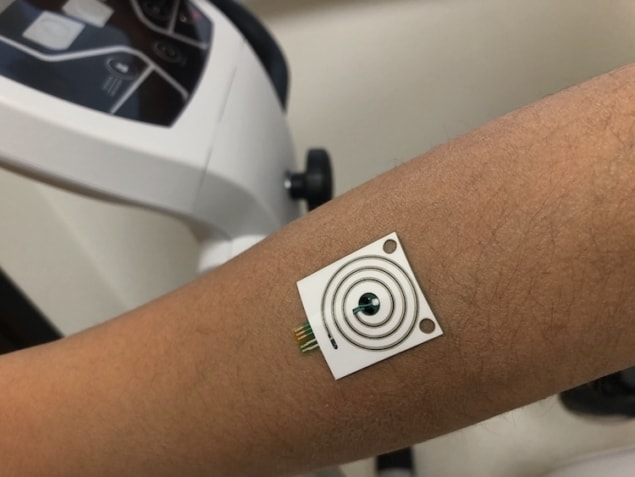
A new scalable, high-throughput fabrication process that makes use of roll-to-roll printing and laser cutting can produce wearable sweat sensors rapidly and reliably and on a large scale. The devices, which can almost instantly detect and analyse electrolytes, metabolites and other biomolecules contained in sweat, could be employed in real-world applications and not just as laboratory prototypes.
Analysing sweat is a non-invasive way to monitor a range of biomolecules, from small electrolytes to metabolites and hormones and larger proteins that come from deeper in the body. Indeed, sweat sensing has already been used to medically diagnose diseases like cystic fibrosis and autonomic neuropathy and to assess fluid and electrolyte balance in endurance athletes.
Traditional sweat sensors collect sweat from the body at different times and then analyse it. This means that the devices can’t be used to detect real-time changes in sweat composition – during physical activity, for example, or to monitor glucose levels in diabetic patients. Wearable sensors, which make use of flexible and hybrid electronics, overcome this problem by allowing for in-situ sweat measurements with real-time feedback. However, it is still difficult to reliably make sweat sensor components (including microfluidic chip and sensing electrodes) in large quantities and with good reproducibility.
Roll-to-roll rotary screen printing and laser ablation
A team led by Ali Javey at the University of California, Berkeley, has now developed a technique to rapidly fabricate sweat-sensing patches using a roll-to-roll (R2R) rotary screen printing process and laser ablation.
R2R is promising for high-throughput and cost-effective fabrication of flexible electronics while laser ablation allows for rapid materials patterning at small scales and is useful for engraving microfluidic channels into flexible substrates, say the researchers. “By combining R2R rotary screen printing of sensing electronics with laser cutting of microfluidic channels, we can make a wearable patch that might be mass produced in high yields,” says team member Mallika Bariya. “This scalability is essential for enabling fundamental studies on large populations with many subjects and multiple devices used per subject.”

The researchers made their device by first screen printing conducting and insulating inks onto a plastic substrate to define and protect the sensing electrodes. They then laser cut a second plastic substrate to define a spiralling microfluidic channel. “Further plastic layers are similarly patterned to create cover sheets to enclose the channel and create an inlet and outlet for sweat to enter and leave the device,” explains Bariya. “The layers have an adhesive coated on one side so that they can ultimately be stacked together to create the device.”
Versatile wearing
The patch can be attached anywhere on the body to locally measure sweat – for example, during exercise, she tells Physics World. The sensor has an inlet well where sweat first accumulates. Sensing electrodes within this well can detect the levels of sodium ions (Na+), potassium ions (K+), glucose and other analytes contained in this sweat. The sweat continues to flow into the spiralling channels of the device, where two further nested electrodes measure sweat rate.
Once testing is complete, the patch can be peeled off and discarded.
Functionalized electrodes
To demonstrate that the patch can support high-performance electrochemical sensors, the researchers functionalized the electrodes with Na+, K+ and glucose sensors. They calibrated each in standard solutions that mimic the physiological sweat concentration range of each of the analytes.
For example, a Na+ sensor was tested in 15 to 120 mM sodium chloride (NaCl) solutions and found to be stable throughout the measurement period with a sensitivity of 56.2 mV/decade. This value is similar to sensors made by conventional lithography-based techniques and is close to the so-called Nernstian ideal.
In the same way, the K+ sensor has a sensitivity of 51.3 mV/decade in 5 to 40 mM potassium chloride (KCl) solutions and the glucose sensor a sensitivity of 1.0 nA/mM with a linear response over the tested analyte concentration range of 50 to 200 mM.
Testing the device
The researchers tested their device by placing it on different areas of the body of volunteers while they pedalled on an exercise bike and measuring their sweat rates and the sodium and potassium levels in their sweat. They found that local sweat rates at certain body sites could potentially indicate when someone is becoming dehydrated. Being able to perform such measurements could be important for athletes since maintaining fluid/electrolyte balance is essential for healthy vital functions.
“Using these wearable patches, we can now continuously collect data from different parts of the body to understand how local sweat loss can estimate whole-body fluid loss,” explains team member Hnin Yin Yin Nyein.

Wearable patch measures sweat in extreme environments
Glucose testing in healthy subjects and diabetics
The UC Berkeley team also used the sensors to compare fasting sweat glucose levels and blood glucose levels in healthy and diabetic cohorts. “We found that a single sweat glucose measurement cannot necessarily replace a finger-stick blood glucose test for indicating whether someone may be healthy, pre-diabetic or diabetic,” says Bariya. “More personalized correlations between an individual’s sweat and blood glucose levels may be possible, however, with further longitudinal testing that take a variety of factors, including age, body mass, diet, and hydration status into account.”
As well as being useful for athletes for monitoring electrolyte and fluid loss to inform training and therapy, the patch might also be used in medical diagnosis or to monitor diseases in which sweat is known to provide useful insights, say the researchers. “Importantly, it could be employed in more advanced large-scale population studies targeting other athletic/medical conditions and biomarkers to probe the clinically or physiologically important information contained in sweat,” explains Bariya. “These studies will help us to continue ‘decoding’ sweat composition.”
The patch is detailed in Science Advances 10.1126/sciadv.aaw9906.



